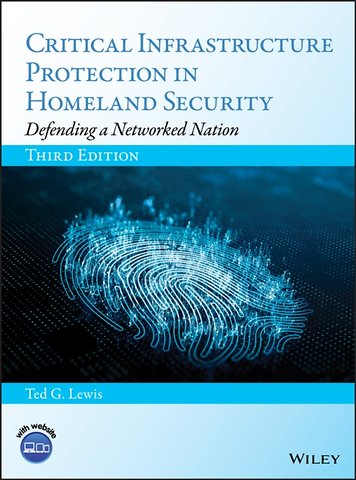Critical Infrastructure Protection in Homeland Security
Defending a Networked Nation
Gebonden Engels 2020 3e druk 9781119614531Samenvatting
Covers critical infrastructure protection, providing a rigorous treatment of risk, resilience, complex adaptive systems, and sector dependence
Wide in scope, this classroom-tested book is the only one to emphasize a scientific approach to protecting the key infrastructures components of a nation. It analyzes the complex network of entities that make up a nation's infrastructure, and identifies vulnerabilities and risks in various sectors by combining network science, complexity theory, risk analysis, and modeling and simulation. This approach reduces the complex problem of protecting water supplies, energy pipelines, telecommunication stations, power grid, and Internet and Web networks to a much simpler problem of protecting a few critical nodes.
The new third edition of Critical Infrastructure Protection in Homeland Security: Defending a Networked Nation incorporates a broader selection of ideas and sectors than the previous book. Divided into three sections, the first part looks at the historical origins of homeland security and critical infrastructure, and emphasizes current policy. The second examines theory and foundations, highlighting risk and resilience in the context of complexity theory, network science, and the prevailing theories of catastrophe. The last part covers the individual sectors, including communications, internet, cyber threats, information technology, social networks, SCADA, water and water treatment, energy, and more.
- Covers theories of catastrophes, details of how sectors work, and how to deal with the problem of critical infrastructure protection’s enormity and complexity
- Places great emphasis on computer security and whole-community response
Includes PowerPoint slides for use by lecturers, as well as an instructor's guide with answers to exercises
- Offers five robust appendices that augment the non-mathematical chapters with more rigorous explanations and mathematics
Critical Infrastructure Protection in Homeland Security, Third Edition is an important book for upper-division undergraduates and first-year graduate students in political science, history, public administration, and computer technology. It will also be of great interest to professional security experts and policymakers.
Specificaties
Lezersrecensies
Inhoudsopgave
U kunt van deze inhoudsopgave een PDF downloaden
Foreword By Prof. Andrew Odlyzko xxi
Preface xxxiii
How to Use this Book xxxvii
About the Companion Website xxxix
1 Origins of Critical Infrastructure Protection 1
2 Risk Strategies 21
3 Theories of Catastrophe 44
4 Complex CIKR Systems 66
5 Communications 101
6 Internet 123
7 Cyber Threats 145
8 Information Technology (IT) 169
9 Hacking Social Networks 189
10 Supervisory Control and Data Acquisition 207
11 Water and Water Treatment 229
12 Energy 249
13 Electric Power 273
14 Healthcare and Public Health 295
15 Transportation 314
16 Supply Chains 334
17 Banking and Finance 349
18 Strategies for a Networked Nation 371
Appendix A: Math: Probability Primer 379
A.1 A Priori Probability, 379
A.2 A Posteriori Probability, 381
A.3 Random Networks, 382
A.4 Conditional Probability, 383
A.5 Bayesian Networks, 384
A.6 Bayesian Reasoning, 385
References, 387
Further Reading, 388
Appendix B: Math: Risk and Resilience 389
B.1 Expected Utility Theory, 390
B.1.1 Fault Trees, 390
B.1.2 Fault Tree Minimization, 391
B.1.3 XOR Fault Tree Allocation Algorithm, 392
B.2 Bayesian Estimation, 392
B.2.1 Bayesian Networks, 392
B.3 Exceedence and PML Risk, 394
B.3.1 Modeling EP, 394
B.3.2 Estimating EP From Data, 395
B.3.3 How to Process Time‐Series Data, 396
B.4 Network Risk, 397
B.5 Model‐Based Risk Analysis (MBRA), 398
B.5.1 Network Resource Allocation, 401
B.5.2 Simulation, 402
B.5.3 Cascade Risk, 402
B.5.4 Flow Risk, 402
References, 403
Appendix C: Math: Spectral Radius 404
C.1 Network as Matrix, 404
C.2 Matrix Diagonalization, 404
C.3 Relationship to Risk and Resilience, 406
C.3.1 Equation 1, 406
C.3.2 Equation 2, 407
Reference, 407
Appendix D: Math: Tragedy of the Commons 408
D.1 Lotka–Volterra Model, 408
D.2 Hopf–Holling Model, 408
Appendix E: Math: The DES and RSA Algorithm 410
E.1 DES Encryption, 410
E.2 RSA Encryption, 410
Appendix F: Glossary 412
Index 414
Anderen die dit boek kochten, kochten ook
Rubrieken
- advisering
- algemeen management
- coaching en trainen
- communicatie en media
- economie
- financieel management
- inkoop en logistiek
- internet en social media
- it-management / ict
- juridisch
- leiderschap
- marketing
- mens en maatschappij
- non-profit
- ondernemen
- organisatiekunde
- personal finance
- personeelsmanagement
- persoonlijke effectiviteit
- projectmanagement
- psychologie
- reclame en verkoop
- strategisch management
- verandermanagement
- werk en loopbaan








